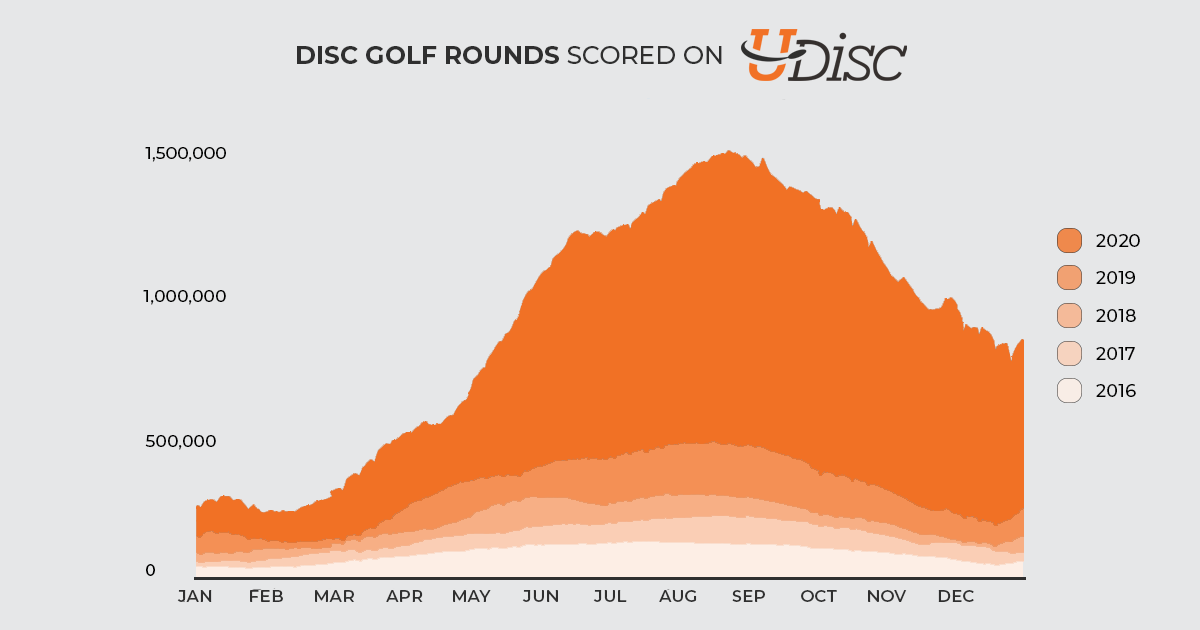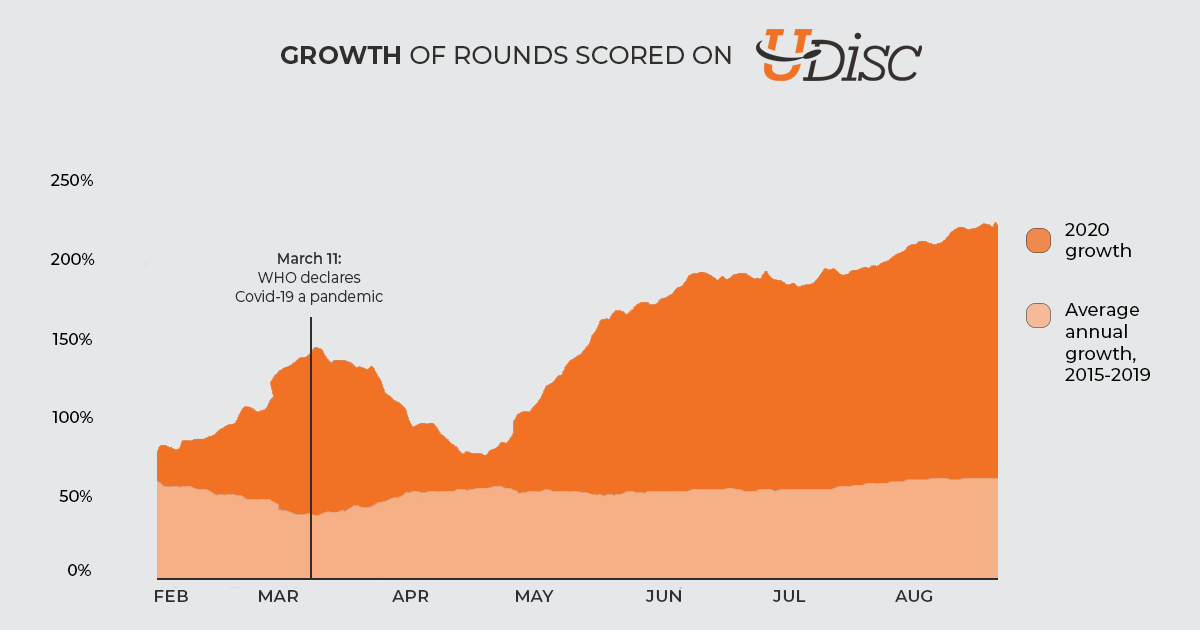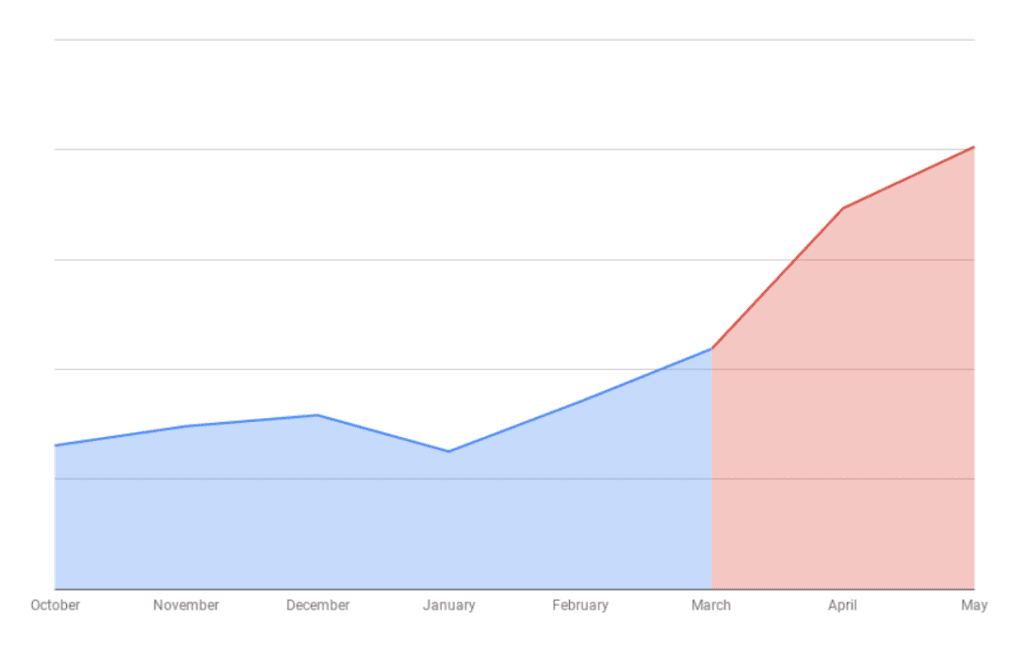If you’ve gone for a walk in a public park recently, it’s likely you’ve seen disc golf baskets strategically scattered about. You might’ve seen people playing, too. Heck, you may even be an avid player yourself! It should come as no surprise, then, that disc golf is becoming an increasingly popular sport.
Is Disc Golf Becoming More Popular?
So, to answer the question directly – Yes, disc golf is growing rapidly in popularity all over the world. It’s one of the fastest-growing sports in modern times, with a 33% increase in games played from 2019 to 2020 alone, according to UDisc, a very popular disc golf scoring app.
You may be wondering what is it about disc golf – regular golf’s younger, laidback cousin – that makes it one of the world’s fastest-growing sports? For starters, it’s free, accessible, and open to everyone at any skill level. Add to those reasons the booming business side of disc golf, and it’s easy to see how the industry is gaining popularity amongst the masses.
How Many People Are Playing Disc Golf Now?
According to the PDGA’s year-end report, there were 53,366 active members worldwide in 2019, and 71,016 in 2020 – that’s a 33% increase in just one year! UDisc, the official app of the PDGA, scores roughly one out of every five rounds of disc golf played. It is estimated that approximately 50 million rounds of disc golf were played worldwide in 2020.

The Disc Golf Growth Report by UDisc.
Beyond these figures, there are many more contributing factors that support the rise in disc golf’s popularity. We’ll explore them here in this article.
Course Creations
Although no one truly knows when disc golf was invented or who really played the first round, it’s been reported that a rudimentary version of it (called “Tin Lid Golf”) was played by Canadian schoolchildren in the early 1900s. From its humble beginnings as an informal, creative playground game, disc golf became popular in the late 1960s-early 1970s. Over time, the rules, techniques, discs, professional associations, and courses evolved to formulate the game we know and love today.
The world’s first official disc golf course was built in 1975 at Oak Grove Park in Los Angeles. From there, the number of courses only skyrocketed. To give you a bit of an updated perspective, 70% of disc golf courses were built in the last decade. Breaking it down even further, 8,463 disc golf courses existed in 2019; one year later, there are 9,342. This equates to about a 10% increase in courses on a global scale…
…and this increase happened smack dab in the middle of the COVID-19 pandemic. While indoor group activities came to a screeching halt in the spring of 2020 due to safety concerns, some outdoor activities saw growth (after the April-May dip pictured in the chart below). Once science and research indicated that outdoor activities, such as disc golf, could be done safely and in a socially-distanced group setting, participation increased exponentially.

The Disc Golf Growth Report by UDisc.
Due to these soaring numbers, more courses were needed. So much so that UDisc states that 3.5 courses were built every day in 2020, which doesn’t include private venues or pop-up courses.
In addition to public parks, other popular disc golf course locations include schools/universities, camps, ski areas, breweries/wineries, and traditional golf courses.
Demand Outweighs Supply
As with any sport that consistently gains participation, the demand for the associated gear and equipment increases. Disc golf is no different. Sure, you can forego the fancy disc cart with the fold-out seat, but playing disc golf without discs just doesn’t work. Disc sales regularly exceed purchases of bags, baskets, carts, and other related accessories, making them the most-purchased item of the entire disc golf industry – which is why the demand for them remains high.

From the PDGA website.
After the initial stay-at-home scare of the pandemic eased up, more people began venturing beyond the walls of their homes. A good number started buying discs and heading to their local courses. When disc golf’s organic rise in popularity combined forces with a (relatively) coronavirus-safe outdoor activity, discs began flying off the shelves.
Literally. Manufacturers like Infinite Discs, Innova, and Discraft couldn’t keep up with the high demand for popular discs such as Zeus, Cloudbreaker, and Buzzz. Even today, these discs – and many others – are constantly sold out and hard to find. Although the majority of disc golf manufacturers and suppliers were deemed “non-essential”, stripped down to a skeleton crew, and were forced to shut down for several months, that didn’t stop people from wanting to purchase discs.

The red area designates the time period during which several manufacturers were forced to close and had limited capabilities to ship and restock. From InfiniteDiscs.com.
Sporting goods retailers, both new and used, continue to see an upward swing in disc sales. And because disc golf is relatively affordable – a decent disc costs around $10 and most courses don’t charge a fee to play – it’s an easy sport to get into.
Another element that contributes to the disc golf boom is the media, which we’ll discuss next.
As Seen on TV
News and live coverage reaches our phones, computers, and TVs with lightning speed these days. For example, JomezPro, a one-stop disc golf shop, has seen rising viewership on their YouTube channel by providing high-quality tournament footage, highlight compilations, and live streams available to anyone at any time. The coverage of the 2019 World Championships garnered more than three million views on YouTube alone.
Television networks are following suit, with major channels like CBS and ESPN airing disc golf tournaments (especially during COVID, when regularly-scheduled sporting events were cancelled. Disc golf coverage filled that void). According to an analysis by ShowBuzzDaily, the ESPN2 broadcast of the Disc Golf Pro Tour Championship Finals last fall drew 225,000 viewers, making it the 78th most-watched broadcast on cable TV that day and the most-watched show on ESPN2 the same day. And for four consecutive nights in August 2020, CBS covered the Dynamic Discs Open. While these things may not seem like much overall, they were definitely significant moments for the sport. By bringing disc golf into people’s homes, the sport becomes demystified, more accessible, and progressively intriguing.
Speaking of tournaments, contracts and sponsorships for top disc golfers like professional Paul McBeth are getting bigger and bigger. In fact, he recently signed a $10 million deal with Discraft. And the pro purse amount has nearly doubled in the past decade, from about $2.2 million in 2010 to $4 million in 2020. This is indicative of the attention disc golf has demanded over the years, as well as the financial investment in the industry and players.
With increased viewership and new talent arising in what seems like the blink of an eye, it looks like disc golf isn’t going anywhere anytime soon.
Women and Youth
As of 2020, there were about 4,800 female members in the PDGA – comprising 7% of the association’s membership, to be exact – compared to over 66,000 men, who make up 93% of the PDGA’s membership. Even though there are more men who play disc golf than women, females are making their presence known in the sport. Players like Paige Pierce and Catrina Allen are helping to promote more women on the course. Local, national, and global tournaments, leagues, and events encourage more females to join forces, pick up a disc, and play.
Although the majority of people who play disc golf are between the ages of 19-50, youth are also getting into it. According to the PDGA, about 6% of their professional membership in 2020 consisted of individuals 19 years or younger. Because skill levels vary greatly between someone who is two years old and someone who’s 18, the PDGA has six Junior groups (≤18, ≤15, ≤12, ≤10, ≤08, ≤06), which offer mixed (male and female) and female-only divisions.

Throwing a regular frisbee is something a lot of us have experienced – whether during childhood or as an adult – which is probably why the transition to throwing a disc golf disc feels natural and not so intimidating. The ease of comfort and sense of familiarity makes it popular among novices, women, and children.
More Reasons for Disc Golf’s Popularity
In addition to getting some fresh air and embracing a free, fun way to exercise, there are many other reasons disc golf continues to become more popular. These positive aspects include, but are not limited to, the following:
- Fit for any skill level, age, and sex
- Can be played alone or with others
- Encourages social interaction (safely) and the development of new friendships
- Can be played year-round in most locations
- Can be competitive or recreational
- Stimulates tourism
- Fosters economic growth
- Provides a constructive use for underutilized public land
- Boosts mood and energy (think stress-reliever!)
Wrapping Up
As you can see, disc golf is undoubtedly becoming more popular across the globe. It’s a cheap, accessible, and easy sport for anyone to learn and love. Like traditional golf, disc golf can be played at any age and at any skill level, which also contributes to its rise in popularity. It just takes one disc and a trip to your neighborhood course to set your disc golf addiction in motion. But don’t worry…it’s one you can be proud of.
For a list of disc golf courses in your area, click here!
